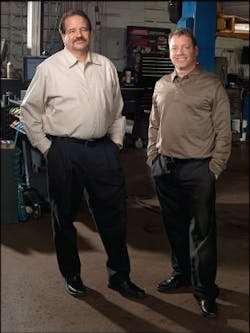When Gerry Frank and Keith McCrone first met 13 years ago on a flight from Las Vegas to Cleveland, they were in nearly identical situations.
Both owned Cleveland-area repair facilities. Both logged extremely long hours in those shops. Both were making just enough to survive. And both were tired of the grind, desperately looking for a way to turn it all around.
That’s the reason they were at the same marketing seminar in Las Vegas, and the reason they first struck up a conversation. But as the two got to talking, it wasn’t so much their similarities that drew them together; it was everything that made them so different.
“Everyone has limitations as an owner, and everyone has things that they’re good at,” McCrone says. “So, if you’re going to improve, you need to either improve those areas you’re lacking—and that your business is lacking—or you need to find someone who can fill those gaps for you.”
Profile: Gerry Frank
Age: 51
Years in the industry: 33
Ownership Experience: Frank bought a Shell service station in 1985. It was later closed by the oil company in 1999. He opened Auto Repair Technology in 2000.
Profile: Keith McCrone
Age: 48
Years in the Industry: 30
Ownership Experience: After years working for Toyota, McCrone opened Automotive Specialty Service in 1996.
“That’s what we were able to do for each other,” Frank says. “We were pretty much opposites, and what we each needed, the other had.”
Frank is a “left-brainer,” as he puts it, a whiz with numbers and a preacher of the gospel of profit margin. McCrone struggled with the finances, but excelled at generating car count and high volumes of revenue.
The two struck up an unofficial partnership, and combining their knowledge and strengths, created a plan—a thorough, written document that turned around both of their shops, Frank’s Auto Repair Technology and McCrone’s Automotive Specialty Service.
“It was fairly remarkable the way the businesses just took off,” Frank says. “It made us really want to test this plan we created. We wanted to do it from scratch.”
Blueprint in hand, McCrone and Frank built Royal Car Care and Tire in 2008.
Twelve months later, the shop had raked in more than $1 million in revenue with net profit margins above 20 percent.
Prove It
In typical self-deprecating, Midwestern humor, Frank says the city of Cleveland owns many records—all bad ones.
“Year after year, we’re acknowledged among the poorest cities,” he says. “It’s a tough area, especially right now with the economy the way it is.
“My point is this: I always hear the excuse that, ‘I’m sure it worked for you, but it can’t work for me. We’re in different situations.’ Well, it worked here in Cleveland—for three shops in three very different areas.”
And Frank is confident it can work anywhere.
Frank and McCrone still separately own their original shops, but in looking at their collective effort, they saw total revenues above $5 million in 2011 in all three shops, and they expect final 2012 numbers to be higher.
“We have one shop that’s in a very affluent area, and another that’s in a much more blue-collar and, honestly, fairly depressed area,” Frank says. “Both have net profit margins above 20 percent using this plan.
1985 — Gerry Frank buys first shop, a Shell Service Station in Cleveland.
1996 — Keith McCrone opens Automotive Specialty Service in Avon, Ohio.
1999 — Tired of diminishing margins on fuel and increasing rent, Frank terminates the lease on his service station.
2000 — Frank opens Auto Repair Technology in Brook Park, Ohio, with his wife, Laura.
2006 — After meeting at a seminar, Frank and McCrone begin working together to turn around their respective shops.
2007 — With businesses beginning to thrive, both McCrone and Frank are able to take a step back from the day-to-day operations starting that November.
2008 — That spring, they begin formulating plan to launch a new shop together.
2008 — Royal Car Care & Tire Center opens that October in Brunswick, Ohio, just four months after McCrone and Frank began planning.
2009 — Just shy of 12 months after opening, Royal Car Care tops $1 million in sales.
“And our new shop, we opened it on a location that saw five different shops go under in the past. Parts vendors were saying to not go in there, but we knew it fit our plan. We started with zero customers there—and I really mean absolutely zero customers—and generated $1 million in the first year.
“It’s not something we’re trying to brag about. The point is that this can work at your shop.”
And McCrone says it really isn’t as difficult as it may seem.
Frank and McCrone broke down the basics of their blueprint for Ratchet+Wrench, and while the exact details will vary from shop to shop, the overall concepts can be applied anywhere at any time, Frank says. It’s not just for shops opening up or expanding. It can be used to overhaul your existing business, too, he says.
The Blueprint
Getting started: The simplest way to think of it, Frank says, is to imagine you’re building a house. “You’re not just going to grab some two-by-fours and some nails and start hammering away,” Frank says. “You’re going to have a complete vision of everything you want from that house, every little detail.”
That’s the idea behind the blueprint for your shop, he says.
Start by creating a full, 360-degree vision of your business. What do you want your shop to be? Are you a high-end import shop? Are you a neighborhood-garage guy? How do you want your business to be viewed by customers?
And, most importantly, what do you expect to get in return from it? What kind of money are you hoping for?
If you can come up with answers to these questions, it’s time to get started.
Putting the Plan Together
Location: Whether you’re an existing shop or opening a new one, the first step is understanding your location—and that means understanding the demographics of the community.
When Frank and McCrone first looked for a new location for the third shop, they went over the demographics of their best 100 customers in each business. They used that information to pick a new location with plenty of those customers in the area.
“So we knew that our best customers were age 40 to 65,” Frank says. “We knew they were married, or at least had a woman in the house. They own their own home. They have children. This tells you who your best customers are, and who you want to target with the new shop.”
In their existing shops, Frank says, the demographic research helped them see whether or not they were serving their current customers well enough. It also helped set up all other aspects of the plan.
Facility: Having the shop in the right place only gets you halfway there. Frank says the actual physical shop needs to meet your goals as well. It needs the right appearance, the right size—a comfortable lobby, office space, a certain number of bays and parking spaces, everything—and the right infrastructure in terms of accessibility for customers.
Expenses and gross revenue goals: Once you have a location and understand the demographics, Frank says, the next step is calculating your estimated costs of running the business. Frank stresses to keep in mind your final goals for the business: How much will it cost you each year to run the type of shop you want?
From there, you can create your gross profit goals.
“The way we set it up,” Frank says, “I like to have my expenses be no more than 25 percent of gross revenue.”
The other key numbers: Knowing your gross revenue goals—your “top number,” as Frank calls it—you can then start to break down all the other important numbers that go into reaching those goals.
Most important are car count and average repair order. The two numbers go hand in hand and, in the end, need to bring you to your sales goals. Your shop’s demographics should help give an estimate of the type of tickets you will bring in, Frank says. And from there, you can determine how many cars you need.
Operations: Now that you know what your shop needs to achieve in order to be successful, Frank says it’s time to plan on how to actually do it. This is where your shop’s operations come in.
“People never forget the way you made them feel,” Frank says. “Long after they’ve driven away and long after they forgot what repair you did, they will still remember how you treated them. Customer service is what everything needs to be predicated on, and honestly, in our industry the bar is set pretty low.
“Every aspect of your operation needs to be focused on going above and beyond those expectations.”
McCrone and Frank compare operations to a four-legged stool. They say each leg is equally important in keeping the stool from collapsing.
The first leg is marketing. “Your job as an owner is to try to absolutely get the best customers,” Frank says. “That starts with marketing.” McCrone and Frank focus their marketing primarily on existing customers and try to only use trackable methods, so they know what’s working and what isn’t. Because of that, they don’t have a specific marketing budget. If something is working, Frank says, they simply do more of it.
Of course, the goal of marketing is to get people to call your shop. So, the second leg of the stool is your phone procedures. Each of his shops have precise scripts to follow on calls to the shop to ensure the right things are said.
The third portion is sales. Shops need to have the right procedures and people in place to be able to sell the repairs that customers need—and they need to do it with integrity and the customer’s well-being in mind.
The final leg is having qualified technicians and standard operating procedures in the shop. “It’s pretty obvious, but it can be overlooked,” Frank says. “You have to have qualified, quality technicians. You can’t afford to be making mistakes. Customers won’t give you that second chance.” Writing down all procedures helps to ensure techs are ready for all situations and prevent those mistakes that can happen from time to time.
Implementation and review: Both McCrone and Frank say shops need to stick to their plans once up and running—or once they start making changes in their existing shops. Everything should be geared toward that original vision of your business, and shop owners should regularly monitor and evaluate how the aspects of the plan are working.
“It can really sound daunting,” McCrone says, “but it’s a lot easier than most people think.
“I know that I couldn’t visualize it at first; I couldn’t figure out how to get there. But when you sit down, and you go through all of this, it starts to become more clear. You start to see that path to take. Then, all you have to do is take it.”
About the Author

Bryce Evans
Bryce Evans is the vice president of content at 10 Missions Media, overseeing an award-winning team that produces FenderBender, Ratchet+Wrench and NOLN.
